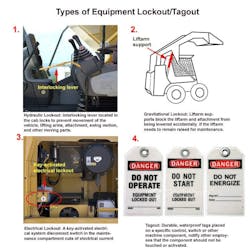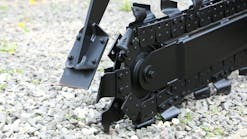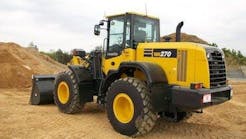Good engineering and advancing technology continue to make construction equipment safer for those who work in and around it. Sometimes, however, the smartest way to prevent an equipment-related accident is to avoid potentially dangerous situations altogether.
One way to do that is through lockout/tagout. With lockout/tagout, you essentially tell other workers that a piece of equipment, in its current state, is too dangerous to operate.
Tagout is the practice of leaving a label on a machine, warning other employees that it should not be touched or activated. Lockout takes the extra step by providing a physical barrier that prevents the activation of a machine or equipment component. The two practices should be used together to maximize safety.
In an accident just a few years ago, a skid-steer-loader operator died when he was pinned between the loader's hydraulic tilt cylinder housing and the frame, according to the Center for Disease Control and Prevention. After the operator exited the skid-steer, he reached down to the foot pedals — which control the loader arms — in order to clean off snow that had accumulated. According to the CDC, the operator may have improperly lowered the safety seat bar in order to raise the bucket for better access to the pedals. As a result, the interlocking mechanism was not enabled. When the operator applied pressure to the foot pedals while he was cleaning them, the lift arms moved and crushed him.
Lockout
"Many accidents are due to people getting caught in pinch points," says Ray Peterson, founder of Vista Training, which produces safety videos and training resources related to lockout/tagout and other heavy-equipment dangers. "They would raise something up in the air, for example, and then fail to adequately block it off from potential movement, and something would slip or fall. You can imagine the potential for fatality or severe injury."
In many skid steer loaders and track loaders, the interlocking mechanism is the seat bar. When the seat bar is raised, the liftarm and bucket are locked into place, no longer able to move. When an operator enters the cab and lowers the seat bar onto his or her lap, motion to the liftarm, bucket and other moving parts is re-enabled. In excavators and some other heavy equipment in which an operator enters the cab through a side door, the interlocking mechanism in several models is a lever attached to the armrest. Hydraulic motion is activated when the lever is down and locked when it is in the up position.
The lift arm of a vehicle is designed to be lowered whenever the cab is vacant. But during service, the maintenance engineer sometimes requires that the lift arm be raised. In this scenario, a lift-arm support must be installed to completely block the arm from falling.
"You raise the arm up and there is a tube that goes over the exposed hydraulic cylinder and pin that goes through it that can be locked in place," Peterson says. "Now, these supports are built in so it simplifies the process."
There is also a potential for electrocution when fleet staff do maintenance work on a vehicle.
"I remember a mechanic showing me a scar the size of a silver dollar on his wrist," Peterson says. "His wrist watch caused an electrical short of a 24-volt battery, and he lost some function in one of the fingers of that hand as a result of the depth of the burn. The whole thing could have been avoided by removing a single cable."
In older equipment, "you can remove a cable from the battery post and there is also a cap that is designed to go over it," Peterson says. "There is often a padlock that can go over it." Consult your machine's manual for the appropriate procedures.
Some equipment manufactured in the last few years has a built-in electrical-disconnect switch that cuts off all electrical power to the machine. Because it is key activated, only the key holder can return power to the machine.
For older equipment that doesn't have lockout mechanisms built in or for fleet managers who want added protection, aftermarket devices can be used.
"Our products for the most part are anti-theft devices," says Bryan Witchey, vice president of sales and marketing at The Equipment Lock Co. "But they are also able to be used in conjunction with OSHA's lockout/tagout safety procedures."
The company's aftermarket locks, which are available for skid steer loaders, excavators, and other types of equipment, immobilize the drive controls of a piece of equipment so that it cannot be stolen by a thief or used by another employee during service or repair.
Tagout
But lockout devices, whether integrated or aftermarket, are only part of the overall solution. Tagging out is an important communication tool and should be done whenever a machine is off limits. For instance, if you are doing machine maintenance, you should write on the tag a brief description of why the machine is out of order. Maintenance employees must place tags on areas of a machine in which a component was removed, as well as on the cab door or drive controls. When maintenance is complete, the person conducting the repair should sign his or her name on the tag, Peterson says.
"Many of the lockout devices that go on these machines also come with a tag designed to be filled out by the person who put it on," Peterson says. "They should be the only ones who have the key and should sign the tag when they take the device off."
Tags must connect to the equipment using a strong piece of wire, durable enough to withstand harsh, wet or dirty environments.
Communication really is the key, Peterson says. That includes educating and reminding your operators, engineers and other fleet staff about lockout/tagout and reminding them about related safety procedures. Fleet employees often are familiar with lockout/tagout, but they sometimes adopt a false sense of security when work becomes routine.
Lockout/tagout actually is quite simple, Peterson says. The challenge is making those safety practices an integral part of your company's culture.





